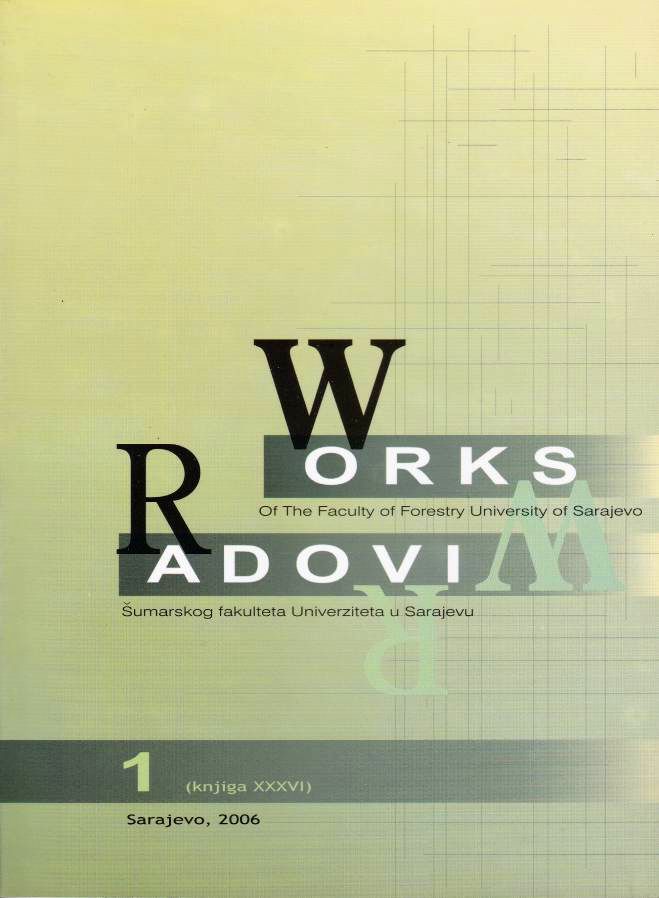The influence of oak mistletoe (Loranthus europaeus Jacq.) to stability of the sessile oak stands
DOI:
https://doi.org/10.54652/rsf.2006.v36.i1.192Keywords:
Quercus petraea L, Loranthus europaeus Jacq, tree trunk decay, agents concatenationAbstract
UDK 630*44:582.632.2
582.632.2:582.728.4
The studies in this paper point at vulnerability of the sessile oak forests from the yellow mistletoe Loranthus europaeus Jacq. The study was carried out in the department 68 of the Forest Management area „Fojničko“, Management Unit „Zahor – Jasikovica“.
The study included a total of 108 trees, 79 or 73% out of which were tainted by mistletoe. The number of bushes, the dryness of the crest and the damages to the trunk were evidenced on the tainted trees. There were all together 300 bushes evidenced, or 3,8 per tree at average. The study verified the existence of positive correlation between the chest diameter (aged oak trees) and the number of the mistletoe bushes (the intensity of the infection of the plant). The position of the bushes on the tree was conditioned by light availability which is necessary for the development of mistletoe as a heliophyl species. Accordingly, it was observed that a side overlay of the tree crowns worsens the conditions for the development of mistletoe, which eventually has positive effects to the health condition of the tree.
Deterioration of the sessile oak health condition comes forward as a consequence of redirection of water and mineral substances towards the mistletoe bushes which grow on the tree crowns. Any additional presence of harmful agents increases the stress effect to the plant. Oak trees with the diminished vitality, that appears as a result of water and mineral substances deficit, are more susceptible to attacks from secondary abiotic and biotic agents (harmful insects, Armillaria and Ophiostoma fungi and similar). Their effects accelerate the process of atrophy of the tainted entities.
Downloads
References
ATSATT, P.R. (1970): Biochemical bridges between vascular plants. In: Chambers, K.L. (Ed.), Biochemical Evolution, Proceedings of the 29th Annual biology Coloqium, 1968, Oregon State Univrsity. Pp. 53 – 68.
CALDER, M., BERNHARDT, P. (1983): The biology of mistletoes. Academic Press, New York.
ELIÁŠ, P. (1988): Quantitative eocological analysis of a mistletoe (Loranthus europaeus Jacq.) population in an oak- hornbeam forest : discrete unit approach. Institute of Experimental Biology and Ecology of Centre of Biological and Ecological Sciences of the Slovak Academy of Sciences, Vol. 7, No. 1, 3-17, Bratislava, CSSR.
HÄRTEL, O.(1937): Über den Wasserhaushalt von Viscum album L. Der Dtsch Botan Ges 55: 310 - 321
IDŽOJTIĆ, M., GLAVAŠ, M., ZEBAC, M., PERNAR, R., BRADIĆ, B., HUSAK. (2006): Žuta imela ( Loranthus europaeus Jacq.) i bijela imela ( Viscum album L.) na području uprave šuma podružnice Bjelovar. Šumarski list br. 3-4/2006., Zagreb.
KAMERLING, Z. (1910): Verdunstungsversuche mit propischen Loranthaceae. Der Dtsch Botan Ges 32: 17 - 24
KOLB, T. (2002): Ecophysiology of parasitism in the plant kingdom. School of Forestry, Northern Arizona University, Flagstaff, Arizona.
KUIJT, J. (1969): The biology of flowering parasitic plants. University of California Press Berkeley
MUJEZINOVIĆ, O. (2007.).Uticaj imele (Viscum album L.) na prirast jele (Abies alba M.) i ulančavanje drugih štetnih biotičkih agenasa. Magistarski rad. Šumarski fakultet Univerziteta u Sarajevu.
NEŠKOVIĆ i saradnici, 2003 Fiziologija
PINTARIĆ, K. (2002): Šumsko-uzgojna svojstva i život važnijih vrsta šumskog drveća. Udruženje šumarskih inženjera i tehničara Federacije Bosne i Hercegovine (UŠIT). Sarajevo.
TSIVION, Y. (1978): Physiological concept of the association between parasitic angiosperms and their hosts – A review. Israel Journal of Botany 27: 103 – 121.
USČUPLIĆ, M., DAUTBAŠIĆ, M.,TREŠTIĆ, T., SELMAN, E., MUJEZINOVIĆ, O., NIŠIĆ, T., JOKANOVIĆ, B. (2007): Bolesti i štetnici obične jele (Abies alba Mill.) u Bosni i Hercegovini. Monografija. Društvo za zaštitu bilja u Bosni i Hercegovini.
ZUBER, D. (2003): Biological flora of Central Europe: Viscum album L. Geobotanisches Institut ETH, Zürich, Switzerland.






















